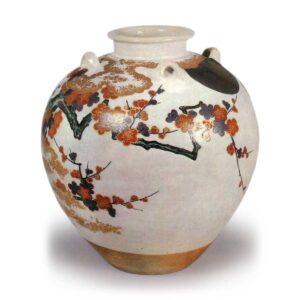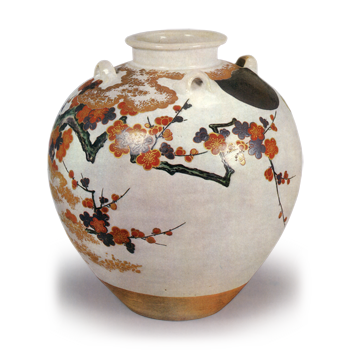
Tea jar with moon and plum blossoms in overglaze enamels
Important Cultural Property
Height 30.0cm, Bore 10.6cm, Body 27.1cm, Bottom 11.4cm
Tokyo National Museum
Of the twelve known tea jars by Insei, this tea jar with wisteria flowers in overglaze enamels and this tea jar are highly regarded as the most technically perfect.
The white glaze applied from the mouth to the base of the body melts smoothly and shows fine penetrations on the front surface.
The body depicts an old red plum tree with the trunk in the center and branches extending to the left and right, with a full moon above the tip of the right branch and around the shoulder. The trunk and branches are painted in purple and green overlaid on black catkins to give the appearance of an old tree. The flowers are painted in red and silver, with gold stamens on the red flowers and red outlines on the silver flowers.
The full moon in the center of the sky is also painted in silver, but the silver is now blackened and rusted, and the gold Genji clouds are painted in fine detail with gold mud heaping, as if gold leaf had been placed on them. These overglaze painting techniques are also unique to Ninsei, and give the work the appearance of being the work of a maki-e lacquer-work artist.
It is also noteworthy that this “tea jar with moon and plum tree design in overglaze enamels” shows the painting style of the Kano School, which is inferred from the fact that the Yongju-fu-shi, a geographical journal of Yamashiro Province written in 1684 (Jokyo 1), states that Kano Tanyu and Eishin were asked to draw underglaze paintings on the piece. It is thought that some of the painted designs on Nisei ceramics were made to order by painters of the Sotatsu or Kano schools. The large seal “Ninsei” is stamped in the center of the left side of the flat bottom.
It has been in the collection of the Tokyo National Museum since 1878, but its earlier provenance is not known.



